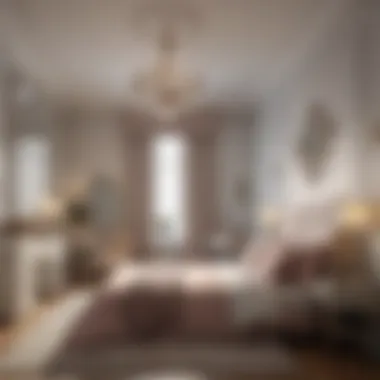Maximizing Space: Smart Solutions for Small Bedrooms


Intro
In an increasingly fast-paced world, living in small spaces has become a common reality for many. Small bedrooms, while cozy, can often feel cramped and chaotic. However, there are numerous effective techniques to create an organized, spacious, and functional living area. This guide explores various strategies for maximizing space in small bedrooms, ensuring that you can transform your room into a comfortable haven with careful planning and intelligent design.
Trending Styles
Modern Minimalism
Modern minimalism emphasizes simplicity and functionality. This style favors clean lines, uncluttered spaces, and a reduction in excessive decoration. Applying modern minimalism in a small bedroom allows one to focus on essential items. It is possible to achieve a peaceful atmosphere by reducing the number of objects in the room. Here are some key elements of modern minimalism:
- Furnishings with a sleek design: Choose furniture that does not overpower the room. Consider wall-mounted shelves and bed frames with built-in storage.
- Neutral color schemes: Use calming colors like white, gray, or beige to create a sense of openness.
- Quality over quantity: Invest in fewer but higher quality items that serve multiple purposes. For instance, choose a bed that has built-in storage drawers beneath.
Cozy Rustic
The cozy rustic style brings warmth into small bedrooms. It combines natural elements with comfortable furnishings, creating an inviting space. Rustic decor typically utilizes wood, stone, and earthy tones. Here are some aspects to consider:
- Natural materials: Use wood for furniture and decor. Rustic wood textures can add a charming element without taking too much space.
- Layered textiles: Incorporate various textures through blankets, pillows, and rugs, making the room feel warm and intimate.
- Plants and greenery: Adding small plants can enhance the cozy atmosphere. They improve air quality and serve as decorative elements without consuming too much space.
Color Palettes
Calming Neutrals
Color choices impact how a room feels and functions. Calming neutrals, such as soft whites, tans, and grays, help create an airy feel, making the space seem larger. These colors reflect light well and can make even the smallest rooms feel more open. Consider these tips when utilizing neutral palettes:
- Accent walls: A single wall painted in a slightly darker shade can add depth without overwhelming the space.
- Complementary shades: Pairing neutral tones with subtle textures can maintain visual interest without cluttering.
Bold Accents
Adding bold accents can provide contrast and personality. While being careful not to overcrowd the room, one can incorporate bright colors through accent pillows, artwork, or other decor.
- Strategic placement: Use bold accents sparingly to avoid visual clutter. One or two pieces can be enough to lift the overall ambiance.
- Varying shades: Combine different shades of a bold color to create dimension without overcomplicating.
To create an open and restful sanctuary, it pays to strike a balance between stylish decor and practical furniture arrangements.
By thoughtfully incorporating these design elements, homeowners and housewives can revitalize small bedrooms. Observing trends and color palettes will aid in crafting a space conducive to relaxation and functionality.
Understanding Space Constraints
Understanding the factors that affect small bedrooms is crucial for effective space management. The design and layout choices you make can significantly impact how spacious your room feels. When dealing with limited square footage, one must grasp not only the physical limitations but also the potential possibilities that come from such constraints. A small bedroom may often pose challenges, yet it can also encourage creativity and innovation in design.
The Nature of Small Bedrooms
A small bedroom is defined by its limited space, which invites a variety of challenges including storage shortages, décor limitations, and less flexibility in furniture arrangements. Small bedrooms can range from compact studio apartments to guest rooms that serve multiple purposes. The nature of these spaces often necessitates a focus on optimization strategies that allow for both functionality and comfort.
When designing a small bedroom, consider factors like
- natural light and how it can be maximized
- flow of movement within the space
- furniture size, shape, and placement These elements can play a fundamental role in transforming a cramped area into a more inviting environment. Creting a harmonious and organized living space is necessary for a small bedroom.
Psychological Impact of Small Spaces
Living in a small space influences not just physical comfort but also mental well-being. The psychological impact of small bedrooms manifests in how individuals feel in their environment. Constricted spaces can provoke feelings of claustrophobia or stress, yet they also have the potential to foster intimacy and comfort when designed thoughtfully.
A well-organized small bedroom can contribute positively to one's mental state. It can encompass:
- Reduced distractions, allowing for focus
- Enhanced serenity, promoting relaxation after a long day
- Encouragement of mindfulness, due to minimized clutter
A calm and organized environment can help mitigate anxiety and enhance overall life satisfaction.
The importance of understanding the psychological implications of small spaces cannot be overstated. A strategic approach to design can result in not only usability increases but also emotional benefits. To cultivate a space that nurtures rather than stifles, one must consider its nature and potential from both a functional and psychological viewpoint.
Initial Assessment
Before diving into the various strategies for maximizing space in small bedrooms, the first step is to conduct a thorough initial assessment. This phase is crucial as it lays the foundation for all subsequent decisions and changes. An effective assessment helps in understanding what is working and what is not in the current setup. It allows you to make informed choices that can be both practical and effective in enhancing the room's utility and comfort.
Analyzing Current Layout
A critical part of the initial assessment involves analyzing the current layout of the room. Observe the placement of furniture, the flow of movement, and how each area is utilized. Consider how often each piece of furniture is used and whether it contributes to the overall functionality. Mapping out your bedroom, either on paper or through design software, can clarify space usage.
When analyzing the layout, ask yourself these questions:


- Is there enough walking space between furniture?
- Do any pieces block natural light or access to storage?
- Are there any areas that feel cramped or cluttered?
By responding to these questions, you can pinpoint areas that require adjustment to improve room flow and accessibility. This could mean rearranging large items like beds or dressers to optimize available space further.
Identifying Unused Areas
Next, it's essential to identify unused areas within the bedroom. Often, even in small spaces, certain sections go unnoticed. Think about corners, under furniture, or even vertical space above head height. These areas can be transformed into functional storage or decorative elements.
To uncover these hidden potentials, consider:
- Corners: Are there corners that could accommodate a small shelving unit?
- Under the Bed: This space is often neglected. Utilize containers or drawers designed for under-bed storage.
- Wall Space: Verticality can be maximized for storage by adding shelves or hooks.
Recognizing and utilizing these previously overlooked spots will contribute significantly to effective space maximization in your bedroom.
"A well-planned layout is the first step towards creating a functional space that feels larger than it is."
By systematically evaluating these aspects during the initial assessment phase, you not only gain clarity but also empower yourself to make specific, measured improvements that will transform your small bedroom into an organized and spacious retreat.
Decluttering Strategies
When managing a small bedroom, decluttering becomes a pivotal part of the overall strategy. The lack of space often results in feelings of congestion and chaos, which can affect both mental and emotional well-being. By systematically removing unnecessary items, one can create a more serene and functional environment. This section explores several effective strategies for decluttering, emphasizing their importance for a small bedroom setting.
Evaluating Necessity of Items
Determining what is truly necessary can be challenging. Begin by assessing each item in the room. Ask yourself questions such as:
- Do I use this item regularly?
- Does it have sentimental value?
- Can it be replaced easily?
Items that are seldom used can often contribute to the clutter. It is crucial to distinguish between necessities and items that simply occupy space. This evaluation is not only about creating physical space but also about encouraging a mindset focused on simplicity and order.
Implementing the 'One In, One Out' Rule
The 'One In, One Out' rule is a practical guideline to prevent clutter from accumulating. Each time you purchase or receive a new item, it is essential to let go of an existing one. This practice fosters mindfulness regarding consumption. It ensures that the bedroom does not become overwhelmed with excess. Additionally, this rule encourages careful consideration of what is brought into the space, promoting intentional living.
Creating a Maintenance Schedule
A cluttered bedroom can quickly revert to its former state without proper maintenance. Establishing a regular schedule for decluttering activities is important. Consider setting aside a few minutes each week to reassess the room. During this time, one can:
- Revisit the necessity of items.
- Tidy up misplaced belongings.
- Identify new items that may need to be removed.
Incorporating decluttering into a routine can help the environment remain organized and peaceful. Consistency is key in maintaining a small bedroom that feels spacious and welcoming.
Regular decluttering not only enhances physical space but also contributes to a clearer mind.
When these strategies are combined, they provide a structured approach to decluttering. This process is an essential step in maximizing the potential of a small bedroom.
Furniture Selection
Selecting the right furniture is a pivotal aspect of maximizing space in small bedrooms. The significance of this topic lies in the need to balance functionality and aesthetics. Small bedrooms require careful consideration in furniture choices. This process can free up essential space while enhancing the room's overall look. Furthermore, it allows for the creation of a serene environment, which is crucial in a confined area meant for rest and relaxation.
Opting for Multifunctional Furniture
Multifunctional furniture serves multiple purposes, making it highly suitable for small bedrooms. Items like a bed with built-in storage or a fold-out desk can make a significant difference. By investing in such furniture, homeowners can easily minimize clutter and make better use of limited space. For instance, a sofa bed can offer both seating and a sleeping area. This kind of furniture helps keep the bedroom organized, reducing the need for excess items that take up precious floor space.
Key benefits of opting for multifunctional furniture include:
- Space-saving: Provides various uses in one compact design.
- Cost-effective: Reduces the need to buy multiple pieces.
- Stylish: Many designs are contemporary and appealing, enhancing decor without sacrificing function.
Choosing Scaled-Down Essentials
When dealing with a small bedroom, choosing scaled-down essentials is crucial. Investing in smaller pieces that fit perfectly in the available space can help maintain flow and organization. For example, selecting a compact dresser or a nightstand with a slimmer profile can save space while still fulfilling needs. Additionally, this approach allows for maintaining a sense of openness, which is often lacking in small areas.
Some considerations while selecting scaled-down essentials:
- Prioritize functionality: Select items that fulfill essential requirements without extra bulk.
- Measure dimensions: Always measure the space available to ensure that selected items will fit well inside the room.
- Harmonize styles: Choose furniture that complements each other and the overall room design to maintain a cohesive appearance.
By carefully selecting the right furniture and being deliberate about choices, homeowners can effectively create a small bedroom that feels spacious and organized.
Optimizing Furniture Arrangement


Optimizing furniture arrangement is crucial for maximizing the usability of small bedrooms. The way furniture is placed affects not only the visual space but also the functionality of the room. Thoughtful arrangement can create areas for relaxation, work, or storage without making the room feel cramped. It is essential to consider the flow of movement within the space, ensuring that it is aesthetically pleasing while also serving practical needs.
Establishing a Focal Point
Establishing a focal point can dramatically transform the look and feel of a small bedroom. A focal point draws the eye and provides a sense of organization. Typically, the bed serves as this anchor in the room. Placing it against the longest wall often allows for optimal use of space. Complementary elements like art or decorative items can enhance this focal point, reinforcing the overall design. Furthermore, a well-placed focal point can create an illusion of depth, making the room feel larger than it actually is.
Utilizing Vertical Space
Vertical space is often an underutilized aspect in small bedrooms. Employing shelves or tall furniture can effectively maximize storage without occupying too much floor area. Shelving units can be arranged above desks or beds, providing easy access while keeping the floor clear. Additionally, tall dressers can serve both storage and aesthetic functions. They draw the eye upward and create an impression of greater ceiling height. Hanging plants or wall art can further enhance vertical space engagingly.
Clear Pathways for Flow
Clear pathways are vital for function in a small bedroom. A well-structured layout aids movement and facilitates an easy transition between different functions of the room. By ensuring a minimum width for pathways, ideally around two feet, occupants can navigate the space without obstruction. This eliminates the feeling of being cramped and enhances comfort. Clear pathways also promote a sense of order, which is essential for a calm environment. Chair and bedside table placements should be deliberate, preventing congestion around bed access.
Visual Techniques to Enhance Space
Enhancing the perception of space in a small bedroom is crucial to create an environment that feels open and inviting. Visual techniques play a significant role in achieving this effect. These methods are relatively simple yet can provide profound benefits. They help in creating a sense of airiness, fostering a calm atmosphere, and avoiding feelings of confinement. Awareness of visual elements can guide decisions on color, lighting, and placement of decoration, which all contribute to a larger perceived space.
Choosing Light Colors for Walls
The choice of color on walls can greatly influence the ambiance of a bedroom. Light colors, such as soft whites, pastels, or light grays, reflect light and make a room feel more expansive. When walls are painted in darker shades, they absorb light, making the space feel smaller and more cramped. An airy feeling can be accentuated by painting the ceiling a lighter shade than the walls, which visually raises the ceiling height.
Additionally, lighter wall colors pair well with various decor styles, allowing flexibility in furniture selection and decor accents. It is important to consider the natural light in the room. If the space lacks sunlight, going too light may create a stark environment. Balancing light walls with warm accents can yield a cozy yet spacious feel.
Incorporating Mirrors Strategically
Mirrors are a powerful tool for enhancing a small bedroom. When positioned correctly, they can create an illusion of depth and width. A large mirror on an opposing wall can reflect light, making the room appear brighter, thus enhancing the perception of space. Choosing framed mirrors can also add style while maintaining functionality.
Small mirrors can be placed in various locations, such as above dressers or on closet doors. This approach ensures the areas feel more expansive without compromising on style. It is vital to consider the placement of mirrors, as they can also create unwanted reflections. Assessing the room layout will help in deciding where mirrors can provide the most benefit.
Limiting Heavy Textiles
The use of heavy textiles can weigh down the visual appeal of small bedrooms. Oversized curtains, thick bedspreads, and dense rugs can create a cluttered look, reducing the sense of openness in a room. Opting for lighter fabrics can help in maintaining a spacious atmosphere. For instance, sheer curtains allow light to filter through while still providing some privacy. These options maximize natural light and visually enlarge the room.
When selecting bedding or upholstery, look for materials with a light feel. This does not mean sacrificing comfort, but finding a balance between coziness and airy design. Incorporating fewer heavy textiles creates a clean aesthetic, which contributes to an overall feeling of calm and spaciousness.
"Visual techniques are essential for transforming a cramped space into an inviting area that encourages relaxation and comfort."
Integrating these visual techniques into a small bedroom strategy can contribute greatly to its overall functionality and design. Whether through light colors, mirrors, or the careful selection of textiles, it is clear that small adjustments can yield significant results.
Smart Storage Solutions
In small bedrooms, efficient use of space is vital. Smart storage solutions serve as the backbone of creating an organized and functional environment. They help in maximizing every inch of area available, ensuring that belongings are stored neatly and effectively. By implementing these strategies, individuals can not only declutter their space but also enhance its aesthetic appeal.
Understanding smart storage solutions goes beyond just stacking items away. It involves strategic planning and consideration of how to use furniture and available spaces to their maximum potential. This section focuses on specific methods that can easily be incorporated into a small bedroom setup.
Utilizing Under-Bed Storage
Under-bed storage is often an overlooked area in many homes, especially in small bedrooms. This space can hold a sizable amount of items, making it an ideal solution for storing seasonal clothing, extra linens, or other less frequently used items.
To start, consider using storage bins or drawers specifically designed to slide under the bed. These can be transparent for visibility or labeled to allow easy identification of contents.
"Under-bed storage can yield a surprising amount of extra space and can make a significant impact on decluttering efforts."
When choosing under-bed storage solutions, ensure that the bins are low enough to fit beneath the bed frame without difficulty. Keep in mind that while it’s easy to push items out of sight, careful consideration of what is stored there is recommended. Regularly assess what is kept under the bed to avoid unnecessary accumulation.
Incorporating Shelving Systems
Shelving systems provide another effective avenue for maximizing space in small bedrooms. Wall-mounted shelves can bring a sleek appearance, and by elevating storage from the floor, they also create a sense of openness. This vertical storage optimally utilizes wall space that often remains empty or unused.
Select shelving that complements the room's décor.
- Floating shelves can display books, photos, or decorative items while keeping the floor space clear.
- Corner shelves make use of areas that are generally neglected.
- Adjustable shelving units can be tailored to meet changing storage needs.
Incorporating these elements thoughtfully can enhance both storage and the room’s overall design. Ensure the shelves are easily reachable and securely mounted to withstand weight without causing clutter.
Employing Hooks and Racks
Hooks and racks may appear simple but they serve as highly effective tools in small bedrooms. They can be used in several ways to free up surface space while maintaining easy access to essential items.


Potential applications include:
- Hanging bags on wall hooks to avoid clutter on tables.
- Towel racks for organizing accessories, jewelry, or scarves.
- Pegboards on walls to customize storage solutions according to personal needs.
When choosing hooks and racks, consider style and function. Select options that blend seamlessly with the overall bedroom theme, while ensuring they are sturdy enough to hold weight without compromising on safety.
Employing hooks and racks can create a layered look that adds character to the room while keeping it functional.
By adopting smart storage solutions such as under-bed storage, shelving systems, and hooks or racks, small bedroom owners can alter the spatial dynamics of their rooms, making them more organized and visually appealing.
Creating a Calm Environment
Creating a calm environment in a small bedroom is essential for promoting relaxation and mental well-being. Small spaces can easily become overwhelming if not thoughtfully organized. By focusing on creating tranquility, individuals can enhance their experience of the bedroom, making it a true sanctuary despite its size. The core elements to consider include minimizing visual clutter and incorporating personal touches that resonate emotionally.
Minimizing Visual Clutter
Visual clutter can contribute significantly to feelings of anxiety and restlessness. In a small bedroom, every item matters. To tackle this, begin by assessing every piece of furniture and decor. Evaluate each object's necessity and emotional value. Consider the following strategies:
- Limit decorative items: Choose a few standout pieces that you genuinely love, rather than crowding surfaces with many small items.
- Hide storage: Use storage boxes or baskets that can neatly tuck away items. This ensures surfaces remain clean and organized.
- Maintain clean lines: Opt for furniture with sleek designs and avoid overly ornate pieces.
- Establish zones: Designate areas for different functions, such as sleeping, reading, and dressing. This can help visually separate spaces and reduce clutter.
By focusing on these elements, it's easier to cultivate a serene space, making the room more inviting and relaxing.
Incorporating Personal Touches
Incorporating personal touches into a small bedroom can create a sense of ownership and comfort. These elements should reflect one’s personality and create a space that feels uniquely yours. Achieve this through:
- Personalized artwork: Select a few pieces of art or photos that bring joy or inspire positivity. This can include family photos, travel memories, or favorite quotes.
- Thoughtful color choices: Select colors that resonate with you. Pastel shades can instill calmness, while energetic colors can uplift your spirits.
- Memory items: Introduce items that have sentimental value, like a cherished book or a memorable gift.
Remember, the aim is to balance these personal touches with the need to keep the space uncluttered. Too many personal items can create chaos. Therefore, choose items with care, keeping the overall atmosphere in mind.
"Creating a calm bedroom environment can foster a greater sense of peace and comfort, making it a true retreat from daily life."
Maintaining the Small Bedroom
Keeping a small bedroom organized is fundamental to ensuring it remains a functional and inviting space. Over time, small areas can easily become cluttered. This can hinder movement, diminish personal comfort, and affect one's overall well-being. Maintenance involves an ongoing process of regularly reinvesting time and effort into organization, which yields numerous benefits.
Moreover, maintaining cleanliness and order gives room for improved mental clarity. A tidy environment often promotes productivity and creates a sense of calm. A well-kept space allows for intentional use of available areas, which can thus amplify perceived spaciousness.
Regular Organizational Practices
Routine organization is a cornerstone of maintaining a small bedroom. Establishing regular practices can significantly simplify this task. One might consider the following strategies:
- Daily Tidying: Practicing short daily tidying sessions helps keep clutter at bay. This involves putting items back in their designated places and removing anything that no longer belongs in the room.
- Seasonal Purging: At least twice a year, a thorough assessment of possessions should be conducted. This ensures areas like drawers and closets do not accumulate unused items.
- Daily Checklists: Creating checklists can simplify the organization process. These lists can include essential tasks like changing bed linens, dusting surfaces, and decluttering visible spaces.
Implementing these methods can lead to a less chaotic environment, allowing one to enjoy the small bedroom more fully.
Reassessing Layout Over Time
The initial layout of a small bedroom may perfect for a certain period, but lifestyle changes and evolving personal needs can render such arrangements ineffective. Thus, it is wise to reassess the layout on a regular basis.
- Identifying Poor Flow: Moving furniture periodically helps determine if each piece serves its purpose. If certain locations create blockages or impede movement, consider relocating or removing them.
- Incorporating New Elements: As lifestyle changes occur, such as bringing in new furniture or decor, these elements should integrate seamlessly into the existing layout. Regular reassessment can spotlight the necessity for updates to fit current styles or needs.
- Adapting to Needs: Sometimes, what worked well previously may not suit current routines. For instance, if you start working from home, you might require a dedicated workspace in your bedroom.
Recognizing the change and being proactive regarding the spatial arrangement can contribute to a functional and serene environment.
Taking time to maintain your small bedroom not only enhances its appearance but also optimizes its functionality, ensuring it remains a sanctuary irrespective of size.
Epilogue
When it comes to small bedrooms, effective organization and strategy are key to creating a functional and pleasant space. The conclusion of this article emphasizes the synthesis of the various strategies discussed prior, all aimed at maximizing the limited space available while enhancing the user's experience. The importance of a small bedroom does not just lie in the area it occupies but also in its potential to reflect personal style and provide comfort.
Recapping Key Strategies
To effectively recap, several fundamental strategies stand out as beneficial. First, decluttering is essential. This involves critically assessing belongings to separate what is truly necessary from items that occupy space without serving a purpose. Implementing the ‘one in, one out’ rule can help maintain this balance over time.
Secondly, furniture selection is crucial. Choosing multifunctional pieces, such as a sofa bed or a storage ottoman, can greatly reduce clutter and optimize the bedroom layout. Furthermore, utilizing vertical space through shelves and hooks can enhance storage options without crowding the floor.
Finally, incorporating visual techniques, such as using light colors and mirrors, can help create an illusion of a larger space. All of these strategies interrelate, forming a holistic approach to small bedroom organization.
Encouragement for Implementation
It is important to encourage readers to take actionable steps toward these strategies. While change may seem daunting, starting with small adjustments can lead to significant transformations over time. Begin with decluttering one area of the room, then move on to furniture selection and arrangement. Each change made can have a profound impact on the perceived spaciousness of the room.
Moreover, maintaining these changes is also crucial. Regularly reassessing the layout and evaluating the items within the space ensures that the bedroom remains organized and aligned with its intended purposes. Readers should see these improvements not as chores but as opportunities to improve their living environment.
"The goal is to create a serene, functional haven in your small bedroom, where every square inch is both practical and pleasing."















